 W
WAcacesia hamata is a species of spider in the orb weaver family, Araneidae. It is typically found in summer months of the eastern half of the United States, south to Argentina. Acacesia hamata is the only species of Acacesia normally found in the United States.
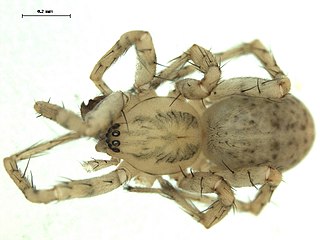 W
WAnyphaena celer is a species of ghost spider in the family Anyphaenidae. It is found in the United States and Canada.
 W
WAraneus niveus is a species of orb weaver in the spider family Araneidae. It is found in the United States.
 W
WAraneus thaddeus, the lattice orbweaver, is a species of orb weaver in the spider family Araneidae. It is found in North America.
 W
WAraneus trifolium, the shamrock orbweaver, is a species of orb weaver in the family Araneidae. It is found throughout the USA and in Canada. The abdomen of Araneus trifolium can have various colors. Most commonly, it is seen in a beige or brown color. Occasionally, the abdomen of the spider has a greenish touch to the brown color or it may even be yellow or orange. In the latter case, Araneus trifolium is sometimes confused with the orange orb weaver species Araneus marmoreus, also called pumpkin spider. The shamrock spider can be distinguished from other orb weaver species by the several white dots on its back. The legs of Araneus trifolium are usually brown or beige colored with several white bands around the joints. The shamrock spider creates a web to catch its prey. Small flying insects who fly into the web will get stuck in the sticky net. The web of an orb weaver can be up to two feet (60cm) in diameter. The bite of a shamrock spider can be painful but it is not dangerous for humans with effects comparable to a bee sting.
 W
WAraniella displicata, the sixspotted orbweaver, is a species of orb weaver in the spider family Araneidae. It is found in North America, Europe, a range from Russia to Kazakhstan, China, Korea, and Japan.
 W
WCastianeira descripta, the redspotted antmimic, is a species of true spider in the family Corinnidae. It is found in the United States and Canada.
 W
WCastianeira longipalpa is a species of true spider in the family Corinnidae. It is found in the United States as well as Canada. It is a type of ant-mimic sac spider, and has most often been observed along the east coast of North America.
 W
WCastianeira trilineata is a species of true spider in the family Corinnidae. It is found in the United States and Canada.
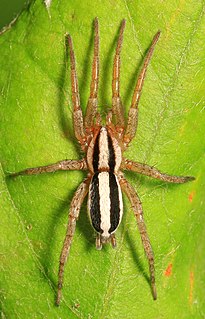 W
WCesonia bilineata is a species of ground spider in the family Gnaphosidae. It is found in North America.
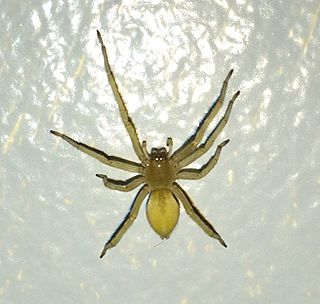 W
WCheiracanthium inclusum, alternately known as the black-footed yellow sac spider or the American yellow sac spider, was formerly classified as a true sac spider, and then placed in the family Miturgidae, but now belongs to family Cheiracanthiidae. It is a rather small pale yellow species that is indigenous to the Americas and can be found living in the foliage of forests and gardens but also can inhabit human homes. Despite common beliefs of necrosis, Cheiracanthium bites cause only localized swelling. C. inclusum is closely related to Cheiracanthium mildei, an introduced species native to Europe which is similar in appearance and natural history and can also be found in North American homes.
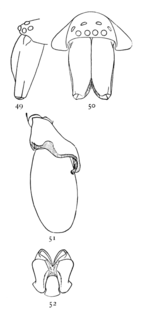 W
WClubiona obesa is a species of sac spider in the family Clubionidae. It is found in the United States and Canada.
 W
WHibana gracilis, the garden ghost spider, is a species of ghost spider in the family Anyphaenidae. It is found in the United States and Canada.
 W
WHypsosinga rubens is a species of orb weaver in the spider family Araneidae. It is found in the United States and Canada.
 W
WHyptiotes cavatus, the triangle weaver, is a species of cribellate orb weaver in the family of spiders known as Uloboridae. It is found in the United States and Canada. It uses an unusual hunting technique whereby it tightens up an anchor line of the web whilst waiting for prey. This effectively winds up and compresses the web. When prey touches the web, the spider releases the held anchor line, causing the web to spring forwards 2-3cm at high speed. This causes up to 4 additional web strands to touch the prey, and the sudden stop when the web reaches the end of its elasticity then winds the prey further into the strands. This process has analogues to the techniques by humans used to power catapults and ballistae.
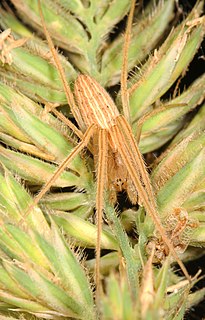 W
WLarinia directa is a species of orb weaver in the spider family Araneidae. It is found in a range from the United States to Brazil.
 W
WMangora gibberosa is a species of spider in the family Araneidae, found in North America.
 W
WMangora placida is a species of spider in the family Araneidae, found in North America.
 W
WMangora spiculata is a species of orb weaver in the family Araneidae. It is found in North America.
 W
WMecaphesa asperata, the northern crab spider, is a species of crab spider in the family Thomisidae, found in North and Central America, and the Caribbean. It is a species of the 'flower spiders', so-called because they generally hunt in similarly coloured flowers for visitors such as bees and flies, and is a much smaller nearctic relative of the better-known Goldenrod Spider.
 W
WMecaphesa celer, known generally as the swift crab spider, is a species of crab spider in the family Thomisidae. Its range is quite large, and it is found throughout much of North and Central America.
 W
WMetepeira labyrinthea, the labyrinth orbweaver, is an American dollar coin-sized spider, with thin legs and a round, bulbous abdomen It is a member of the genus Metepeira in the family Araneidae. The female’s length is 5.3 mm, its carapace 2.3 mm, abdomen 3.3 mm, and extended legs 18.4 mm. The carapace is brown or gray, and the abdomen is dark with a white pattern. The legs alternate pale brown and dark brown, and the sternum is dark brown with a longitudinal yellow mark. The male spider is three-quarters of the female’s length, or slightly larger, with a darker carapace and with greater contrast between dark and light areas of the legs. Metepeira are easily distinguished from other Araneidae by their light eye region, white median line on the sternum, relative length of the leg segments, small male palpus, weakly sclerotized epigyne and the special composite web.
 W
WNeoscona domiciliorum, commonly known as the spotted orbweaver or redfemured spotted orbweaver, is a spider in the family Araneidae. The specific epithet domiciliorum means "of dwellings" in Latin and refers to the fact that this species is often found living on buildings. Their bites are not known to cause serious harm in humans.
 W
WNeoscona pratensis is a species of orb weaver in the spider family Araneidae. It is found in the United States and Canada.
 W
WPardosa proxima is a wolf spider species with a distribution of "Macaronesia, Europe, Russia, China".
 W
WPhrurotimpus alarius is a species of true spider in the family Phrurolithidae. It is found in the United States and Canada.
 W
WPisaurina dubia is a species of nursery web spider in the family Pisauridae. It is found in the United States.
 W
WStrotarchus piscatorius is a species of true spiders in the family Cheiracanthiidae. It is found in the USA and Mexico.
 W
WSynema parvulum is a species of crab spider in the family Thomisidae. It is found in the United States and Mexico.
 W
WTrachelas tranquillus, the broad-faced sac spider, is a species of true spider in the family Trachelidae. It is found in the United States and Canada.
 W
WWulfila saltabundus is a species of ghost spider in the family Anyphaenidae. It is found in the United States and Canada.
 W
WXysticus ferox, the brown crab spider, is a species of crab spider in the family Thomisidae. It is found in the USA and Canada.